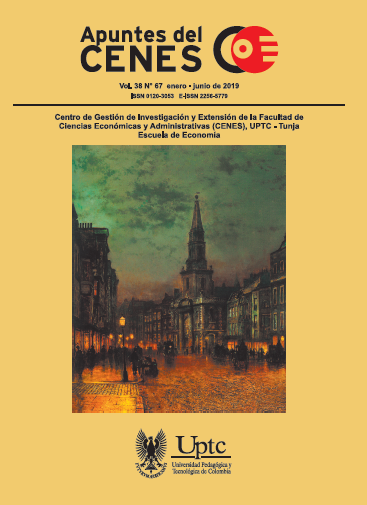Access to Credit, Technological Innovation and Global Integration of Argentine Companies 2010-2012

Abstract
Based on data from ENDEI (2010-2012) this paper analyzes credit constraints that Argentine companies face to implement innovative activities. The evidence shows that constraints are tighter for SMB compared to big companies. Using OLS we also estimate differentials in investments on innovation between firms that have access to credits to finance their innovation compared to those that are constrained. We find that, after controlling for different characteristics, firms that are not constrained invest 30,74% more in innovation, on average, than constrained firms. This difference is decrescent with the size of the companies. Finally, using a linear probability model we evaluate the relation between credit access and the likelihood of global integration of Argentine companies. Our findings indicate that having access to credit for investing on innovative activities is related with a higher probability of exporting, which is consistent with theoretical developments that point to the existence of a complementarity between innovative investments and the export ability.
Keywords
Credits, R&D, Technical Change, exports, investment, Argentina
References
- Arrow, K. J. (1962). Economic welfare and the allocation of resource for inventions, in the rate and direction of inventive activity: economic and social factors. N. Bureau. DOI: https://doi.org/10.1515/9781400879762-024
- Bebczuk, R. N. (2010). Acceso al financiamiento de las PyMEs en Argentina: estado de situación y propuestas de política. CEPAL.
- Barquero, A. V. (2007). Desarrollo endógeno. Teorías y políticas de desarrollo territorial/Endogenous development. Theories and policies of territorial development. Investigaciones regionales, (11), 183.
- Brealey, R., Leland, H. E., & Pyle, D. H. (1977). Informational asymmetries, financial structure, and financial intermediation. The journal of Finance, 32(2), 371-387. DOI: https://doi.org/10.1111/j.1540-6261.1977.tb03277.x
- Brambilla, I., Lederman, D., & Porto, G. (2012). Exports, export destinations, and skills. American Economic Review, 102(7), 3406-38. DOI: https://doi.org/10.1257/aer.102.7.3406
- Brambilla, I., & Peñaloza Pacheco L. (2016). Exportaciones, salarios e innovación tecnológica. Departamento de Economía. Universidad Nacional de La Plata.
- Castillo, D., & Crespo, P. (2011). La financiación de la innovación empresarial. Nuevas tendencias en financiación empresarial: Bases conceptuales y aplicaciones prácticas, 12, 145-164.
- Díaz, O. (2010). La influencia del crédito en la inversión privada. Banco Central de Bolivia. Documento interno de discusión.
- Guzman, M., Ocampo, J. A., & Stiglitz, J. E. (2017). Real exchange rate policies for economic development (No. w23868). National Bureau of Economic Research. DOI: https://doi.org/10.3386/w23868
- Hall, B. H., & Lerner, J. (2010). The financing of R&D and innovation. In Handbook of the Economics of Innovation (Vol. 1, pp. 609-639). North-Holland. DOI: https://doi.org/10.1016/S0169-7218(10)01014-2
- Kugler, M., & Verhoogen, E. (2011). Prices, plant size, and product quality. The Review of Economic Studies, 79(1), 307-339. DOI: https://doi.org/10.1093/restud/rdr021
- Martinez Chafer, L., & Molina Morales, F. X. (2011). Restricciones en la financiación de la innovación. El caso de la Comunidad Valenciana. Investigaciones Europeas de Dirección y Economía de la Empresa, 17(2). DOI: https://doi.org/10.1016/S1135-2523(12)60056-2
- Nelson, R. R. (1959). The simple economics of basic scientific research. Journal of political economy, 67(3), 297-306. DOI: https://doi.org/10.1086/258177
- Stiglitz, J. E., & Weiss, A. (1981). Credit rationing in markets with imperfect information. The American economic review, 71(3), 393-410.
- Ughetto, E. (2009). Industrial districts and financial constraints to innovation. International Review of Applied Economics, 23(5), 597-624. DOI: https://doi.org/10.1080/02692170903007599
- Vázquez-Barquero, A. (2000). Desarrollo endógeno y globalización. EURE (Santiago), 26(79), 47-65. DOI: https://doi.org/10.4067/S0250-71612000007900003
- Verhoogen, E. A. (2008). Trade, quality upgrading, and wage inequality in the Mexican manufacturing sector. The Quarterly Journal of Economics, 123(2), 489-530. DOI: https://doi.org/10.1162/qjec.2008.123.2.489
- Wooldridge, J. M. (2010). Econometric analysis of cross section and panel data. MIT press.
- Yoguel, G., & Boscherini, F. (2001). El desarrollo de las capacidades innovativas de las firmas y el rol del sistema territorial. Desarrollo económico, 37-69. DOI: https://doi.org/10.2307/3455964
